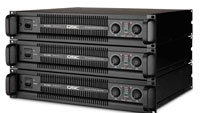QSC introduces PowerLight 3 amps

With three models ranging in size from 2500W to 8000W, QSC's new PowerLight 3 Series amplifiers bring a new degree of flexibility to touring and installed sound reinforcement applications. With a choice of DSP with remote control and monitoring via BASIS, or performance as a straightforward analog device, the lightweight, 2RU lineup facilitates a wide-ranging level of networked functionality.
Each PowerLight 3 model delivers higher input voltage and selectable sensitivity, adjustable via rear-panel switches with color-coded LED indicators. PowerLight 3 amps work well with any existing processor or console. When complete integration of amplifier control, monitoring and DSP is required, however, the series offers full facilities for the QSControl.net/BASIS network audio platform's drag-and-drop DSP functionality. Lesser DSP requirements can be met with QSC's DSP4 processing module.
The top-of-the-line model is the 8000W PL380, incorporating two Class D channels, notable for offering more than twice the audio horsepower of any previous 2RU PowerLight amplifier. Within the PL380 circuitry, reactive back EMF from the loudspeakers is recycled into the power supply to help promote a plug-to-plug efficiency rating of 85 percent that reduces AC power consumption to a bare minimum while offering exceptional headroom.
Models PL325 and PL340 share the same features, matched to upgraded versions of QSC's most advanced linear, Class H amplifier platform. Increased power supply capacitance in both amps is responsible for boosting 2ohm power ratings to approximately 2000W per channel in the PL340 and 1250W per channel in the PL325.
All models use back-to-front airflow to aid cooling, and have the same chassis size and read layout. Other shared features include detented gain controls with 1dB increments; removable knobs with a lockout security plate; three selectable input gains of 1.2V, 32dB or 26dB; and QSC's parallel Dataport, which works in tandem with XLR/M and XLR/F connectors to promote simple loop-through operation.
For more information, visit www.qscaudio.com.
The professional video industry's #1 source for news, trends and product and tech information. Sign up below.
